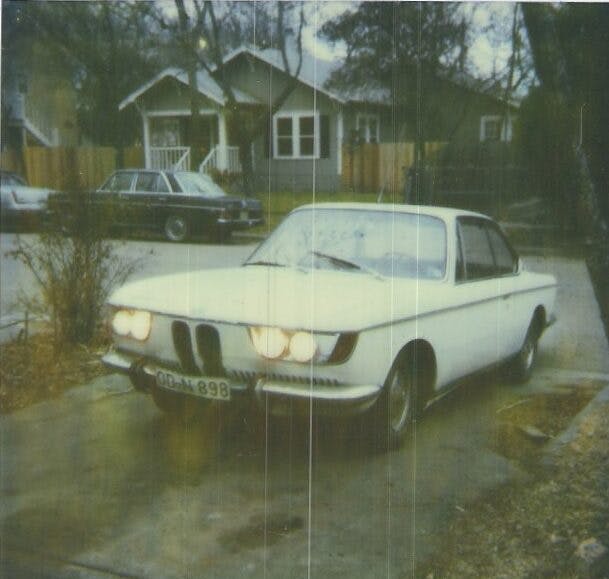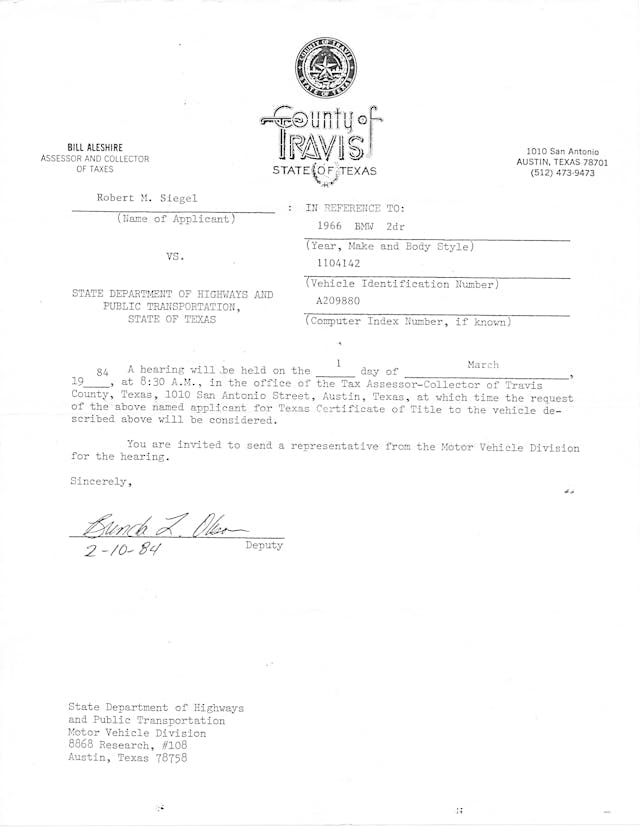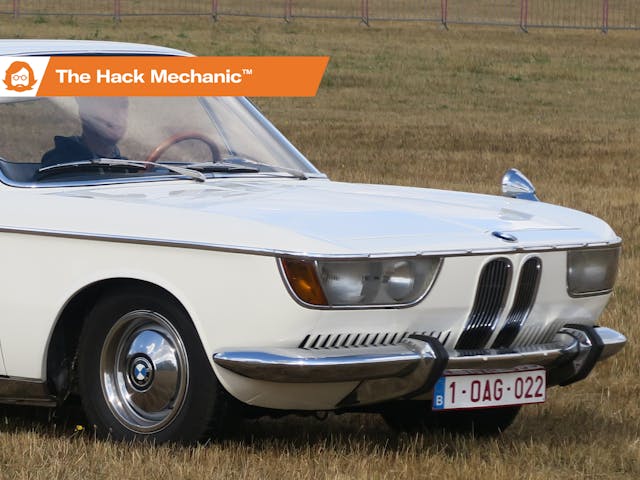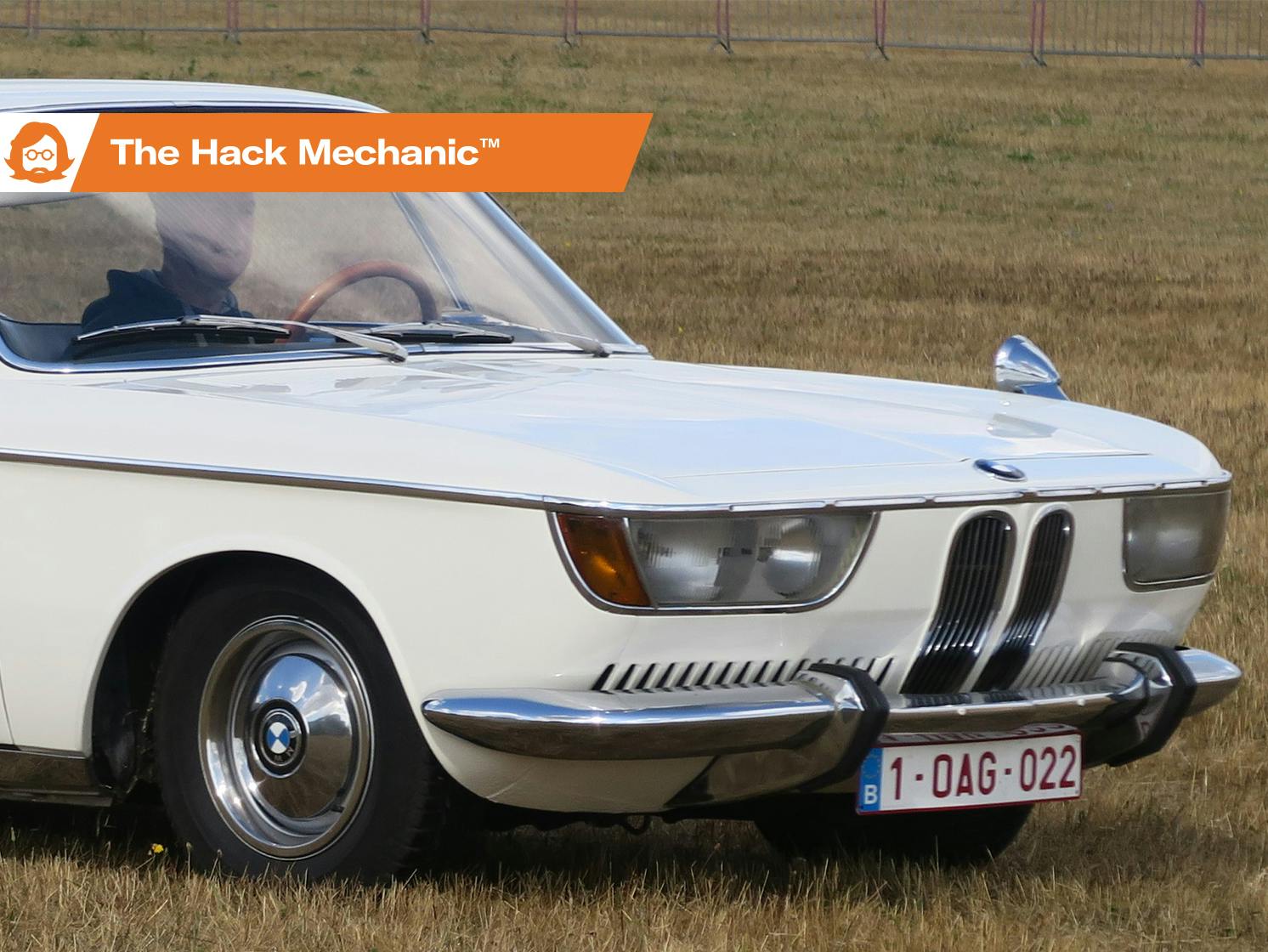Media | Articles
That time I had to have a title hearing

A few weeks ago, I wrote about the closing of “The Vermont Loophole”—that too-good-to-be-true situation where you could legally register a 15-year-old car in Vermont without a title or prior registration and without living in Vermont, and do it all by mail. It gave me a flashback to an episode in those pre-Internet days 40 years ago before you could look this stuff up online and where I was over a barrel over a title and not sure what to do about it.
It happened during that short 2½-year window when my then-girlfriend (now-wife) and I were living in Austin, Texas. I bought my first BMW 2002 there in 1982. This triggered a virtual avalanche of 2002s that I fixed and sold, or traded up for a nicer one and sold the one I had. I took to driving around Austin and looking down people’s driveways to find dead cars.
It was then that I saw my first BMW E9 coupe (the 2800CS / 3.0CS / CSi). These two-door, six-cylinder coupes weren’t boxy like the little four-cylinder 2002 sedan; they were lithe and sexy. Unfortunately, they were expensive. You could find solid pretty running 2002s for two or three thousand bucks, but intact E9 coupes were 10 grand even back then.

But in 1983 I saw an ad for a car I didn’t know existed—a 2000CS. It’s the four-cylinder predecessor of the six-cylinder E9 coupe, built 1965–69 as an offshoot of the “Neue Klasse” four-door, four-cylinder sedans that preceded the 2002. The body of the 2000CS is identical to the E9 coupe from the firewall back, but the front is shorter, as it only needs to hold a four-cylinder engine. The slanted-back “shark nose” lacks the pair of horizontally-slatted grilles flanking the center double kidney that became BMW’s signature look. Instead, a pair of unusually narrow kidneys sit alone in the nose’s unbroken sheet metal, and vertical slats in the nose for air flow to the radiator are partially hidden behind the front bumper. The cars had dual headlamps behind glass covers, making them look a bit like a cross between a praying mantis and an electric razor. Like the Neue Klasse sedans, the 2000CS was never imported into the United States through a dealer network, and many examples that were brought in individually through the “gray market” had these replaced with standard round U.S.-spec headlights. There was also a 2000C variant which had a single downdraft Solex carburetor instead of the CS’ twin sidedrafts.
When the first E9 coupe—the six-cylinder 2800CS—was created in 1968, the front was lengthened enough to accommodate the straight-six engine, and the nose, grille, and headlights were restyled, giving the car the timeless look that now makes nice E9s worth six figures. In comparison, the 2000CS’ shorter hood, underdeveloped nose, and narrow wheel track make it look more dated than its elegant E9 big sister.
Marketplace
Buy and sell classics with confidence

But in 1983, a 2000CS was the BMW coupe that I could afford. The one in the ad was a 1966 single-carb 2000C, and it was cheap—$2500 (that’s about $8000 today). Although it had a recently-swapped 2002 engine and a rebuilt transmission, the low price reflected three caveats.
The first was that the car turned over and started, but barely ran. This was fine with me. I’d already cut my teeth on half a dozen dead 2002s. The engine, ignition, and fuel delivery systems on the 2000C were the same. If it being dead held the price down, I was all for dead.
The second and more serious issue was that the car had suffered a right front wheel bearing failure catastrophic enough to ruin the front stub axle. Since the car, like all Neue Klasse BMWs, had McPherson struts, where the strut housing and the stub axle were part of the same integral unit, the entire strut housing needed to be replaced. I’d replaced strut cartridges before, so the strut removal and replacement wasn’t an issue. Obtaining a replacement strut housing for this never-commercially-imported car was, however.

The last issue was the one I should’ve been the most concerned about. The seller said that the car was his, but he had no paperwork for it. The story was that he’d taken it in trade for back rent owed by a tenant, was still on good terms with her, and if I bought the car, he’d ask her to get a duplicate title and then sign it over to me.
Bad idea.
You saw that one a mile away, didn’t you? Hey, I was 25 years old. I was smitten. There wasn’t another affordable 2000C/CS or E9 on the horizon. I gleefully paid him the money, had the car towed to my house, and could scarcely believe that I owned a BMW coupe, even if it wasn’t the coupe.

Ah, youth. I wasn’t the least bit concerned about the title. The seller seemed like a nice guy. It was an early example of my being too willing to believe people when they have a motive to lie. No, my worries were about the need for a front strut housing. Since this was a BMW that was never sold in the United States (more than just the model—the entire Neue Klasse platform predated a U.S. BMW dealer presence), the odds of finding the part in a junkyard were essentially zero.
When bought my first 2002 a year and a half earlier, I’d made friends with Terry Sayther who ran the independent BMW shop Phoenix Motor Works in Austin. I pulsed Terry on the problem. He had a parts source in Germany, but keep in mind that this predated the widespread use of email by about 15 years. I had to write the fellow a letter. He responded, quoting me a price. I put a check in the mail. We’re talking three trans-oceanic snail mails.
The car needed a lot of other sorting out, so it’s not like I had nothing to do. I put the nose up on jack stands in the carport of our little rented duplex at 101 West 35th Street, where car friends tell me you can still see the oil stains from my presence 40 years ago. I pulled out the mangled strut and disassembled it with spring compressor. I performed the requisite fluid changes and ignition component replacement and got the car running well.
During this period, I called the seller at regular intervals. He said his former tenant had moved, but he had her contact information and the issue of the title was in process.
Finally, nearly six months later, as the calendar rolled over to 1984, the replacement strut housing arrived. I transferred the strut cartridge, spring, and upper bushing onto it and installed it in the car, along with new wheel bearings on both sides and fresh rotors and pads. By the end of the weekend the car was moving under its own power. I was ecstatic.
Except that I couldn’t register it because I still didn’t have a title.
I called the seller again. I got strident. He got testy. I asked for his “tenant’s” contact information so I could pursue it myself. He hung up on me. I left messages for him at his work place. He blew me off. I began to realize that nothing was “in process.” All I had was a big problem.
As I was a relatively recent transplant to Texas, I didn’t know where to turn. I asked around and was told that the thing to do was request a hearing with the county tax assessor, as their office had the power to grant me clear title. I filled out the necessary forms and made the appointment. I waited nearly a month.

When the time came, I went into the county tax assessor’s office, armed with notes of my correspondence with the seller but hyper-aware that there was a danger that a nervous-talking New York-Massachusetts-Yankee-transplant might not necessarily mesh well with whoever was lord of this particular domain. I pled my case as best as I could. I’m just enough of a nerd that I may have even ended with “Help me, Travis County tax assessor. You’re my only hope.”
When I was done, he squared up my papers, furrowed his brow, and nodded slowly.
“You have this feller’s work phone number?”
“Yes, sir.”
“Well,” he smiled, “Why don’t we just ring him up and hear his side of the story?”
I was mortified. I was certain that I was odd man out, that the assessor and the seller would do the secret Texas telephone handshake, and that Yankee BMW boy would be hung out to dry. But there was nothing I could do but bear mute witness to what was about to transpire.
With me sitting right there in the office, the tax assessor dialed the seller up at his job. The assessor summarized the facts as I’d presented them, and asked the seller to respond. The seller claimed that he was helping me, but I was impatient, and if I just trusted him, he’d do what he said he’d do and get the title from the previous owner. The assessor asked exactly what he was doing to contact the previous owner, and the seller said he was working on it. The assessor thanked him for his time, hung up, put his thumb and forefinger on his chin, and thought for a moment. Then he looked at me. My fate hung in the balance. It was probably three seconds, but it felt like an eternity.
“Well,” he said. “That feller’s clearly a lyin’ sack of s**t. By the power vested in me by Travis County, I hereby grant you clear title to your Bee Emm Dubya.” He stamped the paperwork.
Never have I been so happy with someone who had complete control over his little fiefdom. I thanked him profusely and drove directly to the registry and plated the car.
The funny thing was that, when I got home, the guy who rented the other half of the duplex came riding up on a motorcycle. He had a huge Cheshire Cat grin on his face. He said he just picked the bike up for a couple of hundred bucks from a guy who was moving out of town. The catch, he said, was that there was no title.
“You go through a lot of cars,” he asked. “Didn’t you just deal with this with that white car that was in the carport for months?”
I rolled my eyes and laid out the whole story. I told him about the tax assessor and advised that he make an appointment as soon as possible.
“Damn!” he said. “I was hoping to ride it down to Big Bend this weekend.”
“I don’t know what to tell you. I don’t think there’s any fast-track way to get it done.”
“I think I’ll go to the registry and try anyway. I’ll play dumb and see what happens.”
The following night, our motorcycle-owning neighbor knocked on my door. He was wearing Cheshire Cat grin #2 and holding a license plate. My jaw hung open. “How the hell did you manage that?” I asked.
“Just lucky I guess.”
The moral of the story is that you can’t always be lucky, but you can always be truthful, respectful, and polite. When someone holds your fate in their hands, you never know what they’re going to do with it. People who you imagine live to rubber-stamp things “DENIED” may surprise you.
***
Rob’s latest book, The Best Of The Hack Mechanic™: 35 years of hacks, kluges, and assorted automotive mayhem is available on Amazon here. His other seven books are available here on Amazon, or you can order personally-inscribed copies from Rob’s website, www.robsiegel.com.
Check out the Hagerty Media homepage so you don’t miss a single story, or better yet, bookmark it. To get our best stories delivered right to your inbox, subscribe to our newsletters.


















Great story, lesson learned but with a good outcome. After buying dozens of cars including collectibles, I tell everybody they have no idea what they’re in for with never-anticipated potential surprises. Buying and selling old cars, even as a hobby, builds you a skill set that can’t be taught or learned fully anywhere without going through it
I owned a 72 3.0 Csi (l) Town and country right hand drive example. I was an idiot to sell it in 1975. I also owned a 71 3.0 CS euro version ( 2270126) and restored it half way. Lacking the $20k for engine and transmission rebuild i sold it and $10,000 worth of nos CS parts collected over 15 years. These parts included a very rare steering wheel with the knurled pattern designed to keep reflections out of the eyes of rally drivers. Sigh. The most beautiful coupe of the 29th century with the posdibke exception of the 1965 Pontiac Grand Prix.
I would suggest the 63-65 Buick Riviera as an even better example of great 2 door styling.
Really good story from your car flipping years, before it was called car flipping. And it is true that in the Great State of Texas that county officials are not as tied to not helping people as BE urban areas. But you should have picked up that stacked headlights Mercedes Benz across from your rental house, those are worth good money today.
I’m glad that the title business with Travis County was no big deal and they saw right through the issue and took care of you.
Used the Vermont Loophole on a motorcycle once. Seller was in FL (as am I), I had a title number and the local FL DMV said contact the owner. The not-local FL DMV said they couldn’t tell me who it was due to privacy rules. “How am I supposed to send this guy a registered letter if you won’t tell me who or where he is?” “Not our problem. Get a lawyer.”
Got a lawyer, took the paperwork to court, clerk looked at it said it looked good, all it needs is the judge’s signature, that’ll be $400 please because you have to file a case to get that signature. (I didn’t have $400 in the bike.)
Discovered Vermont, yep, all ya need is a bill of sale, doesn’t need to be notarized, send it in with $23. (The vehicle had to be older than 1980 (check) and under 300ccs (check, it is 297ccs). Mongo signed the bill of sale in red crayon, I had a Vermont registration and Antique Vehicle plate two weeks later.
Trip to the local DMV, $25 more and bingo, I now have a gen-you-wine Florida title in my name. Didn’t even need to have the local PD verify the serial number! Easiest “paper problem” I have ever solved.
(One day I will mention a bright red 1968 280SL (grey market) and US Customs ordering me to present it to be crushed because I didn’t file some obscure form a year ago – but I did, and I had kept copies of absolutely EVERYTHING. When I sent them a copy of they decided to leave me alone and I never heard from them again.)
Bought a ’49 Chevy Styleline Deluxe sedan in upstate NY in 1986 for $500 (in non-Deluxe all original condition) on a whim after the garage shop it was at helped me troubleshoot the broken distributor shaft on my’ 68 Buick 225 convertible he’d just towed to his shop. As a 19 year old car nut Navy sailor I felt I had just accomplished true status as a car collector.
Several years later I got out of the Navy and brought the car home to PA. NY didn’t issue titles for older cars back then, all I had was the registration from the year I bought it. PA would accept the registration for a PA title, but it had to be current. NY would let me renew it by mail, but as I no longer lived at the same address, I’d have renew in person with the car – for a VIN rubbing – to change the address.
Now the rub. Now a college student, I was down to an old Yamaha 650 for transportation, and it was December and I really wanted a car in the winter.
Called the physically closest NY DMV – Staten Island, I was just south of Philly – and he graciously offered if I brought just the VIN plate he’d be happy with that.
So on a snowy Dec 7th, 1992 I rode my Yamaha over the Verrazano bridge and got a NY tag using my PA address. I renewed that tag for 8 years until I sold the car, as NY registration was less than PA.
I’ve been pretty lucky in California with a no title motorcycle or scooter a few times. If the thing is not “in the system” all you need is a Bill of Sale (no notary needed), a signed statement from the seller that, to their knowledge, the thing has not been operated on a public road in at least 7 years, and the usual application for a new registration and a new title because the old one is lost or missing. You have to get it to a limited number of CHP stations or any DMV for the inspection of the VIN, or have a certified VIN verifier come to you to inspect the VIN. There are no safety inspections in California.
When I bought my 1960 Goggomobil TS400 from a guy in California in 2005 and had it trucked to my home outside of Boston, I suddenly encountered Massachusetts DMV’s way of dealing with little-known makes. “Nope.” Goggomobil was not a name in the system, and there wasn’t a way to get it in, according to the clerk. My wonderful wife spent many hours in the DMV office while I had to be at work, advocating for the little red car and me. We finally turned to the local microcar guru, Charles Gould. He’s a lawyer and owned half a dozen Goggo’s at the time, plus many dozens of other little cars (“my therapist won’t let me say how many”). He told us the magic word to say: “Glas.” That did the trick, and I drove and enjoyed the car for 10 years. Thanks again, Charles!
Learned my lesson on titles when I was young. Bought a 1965 SS Impala that had no engine or tranny but I had a 327 4 speed for it. The guy said he had the title and to stop by in a couple of days and he would give it to me. I paid him the $500 and hauled the car home. I went by his place the next day and he wasn’t there. I waited for hours and finally his neighbor came out and told me he worked odd hours and was hard to catch at home. That began a 6 month ordeal and I never ended up getting the title. Sold it for scrap after I got what I could use off it. Now if it doesn’t have a title I’m not interested. I don’t care how good the story is or how cheap it is.
Dan,
Agreed, “no title” is a problem, but it can usually be solved one way or another. Storage lien, affidavits, title bond, Vermont “equivalents”, and so forth. The nice thing about DMVs is that their regulations are written by Vogons, and Vogons have no imagination, they only follow established procedures most of which they don’t understand and none of which require any thinking. To resolve title issues you just have to be smarter than they are, which is NOT a really high bar to clear . . .
Example, I have a Florida title which was issued to me in 1969. On presentation to the local DMV (for address update on registration) they advised me that this wasn’t a Florida title. (Old titles were very light blue to prevent photocopying, newer ones are brownish.) Took a (digital) photo of it, sent to DMV HQ in Mordor – er Tallahassee – told them to find their oldest employee, they’d recognize it – they did, she did, all OK.
The trick with dealing with bureaucrats (and not just those at the DMV) is to be polite, and keep trying quietly until you find one who agrees with you or is asleep, then you can get whatever you need or want. Frontal assault does NOT work, these are all retired East German border guards who got fired for bad attitude.
Ever try to change the title on a boat? They don’t have one, and DMV is totally unconcerned about ownership. However, that trailer under the boat is a big deal with title transfer. My state requires transfer to be completed within 10 days of purchase, a fact I had neglected. I waited 6+ months to transfer, as the boat was in storage, and arrived at DMV with my stack of “old” paperwork. I arranged the papers on the clerk’s desk only to be informed that there was a $25 / month fine for late registration! When she turned around to calculate my total fine, I grabbed all of my papers and ran for the door, literally. I acquired a more recently dated Bill of Sale from the understanding seller, and completed the transfer at a different DMV office. Morale – never be afraid to seek a second clerical opinion with “corrected” paperwork.
I’ve had my classic all my adult life, from back when all the paperwork was filled out by hand, and the optional (for vehicles over ten years old) $55 title was widely agreed to be a waste of money. At some point an error in the V.I.N. was introduced. I knew about it but never took it seriously while I neglected the car for a long time. Long enough that the RMV had purged all records of it ever existing. My years of consecutive expired registrations and excise tax receipts were all off by one number. This was a NIGHTMARE to resolve but part of it involved a policeman visiting my home to read the number into his radio and being told, while I listened, the number was invalid because there weren’t enough digits. Ultimately the RMV manually keytyped my car back into their system just like a brand new vehicle. Even though the title now cost $75 I think it was a fair price.
More DMV follies . . . There’s a website (somewhere, I haven’t used it in years) into which you can type a serial number and it returns the vehicle, but not the owner or the address. Only works in FL. I have a specialty, low production motorcycle serial number 00##. (Numbers obscured for security reasons.) The website told me that SN 00## was either my motorcycle, several trailers, a boat, two mobile homes or a dump truck. So much for “standardized 17 digit VINs that all vehicles are required to have”. I think it is the motorcycle because it has a wheel in the front (I assume it is the front because there is a big light on that end), a wheel on the back (it must be the back if the other wheel is the front), and a BIG engine in the middle. I guess I should take it by the local DMV and get an expert opinion.
Love the story… BUT, I think you are wrong on the import history. I bought a 2000CS around 1980. It had the factory sunroof and a few other things. For me, it was rare and also cheap, a combo I couldn’t pass, so I grabbed it as a restoration project. It was 9 years before it hit the concours circuit and after several summers of shows (and Trophies) it landed in the Berhing Museum. One of the things that everyone agreed on was that Max Hoffman had brought over about 35 of them and 5 or so had the factory sunroof. Nice car, rare and since most people didn’t know it existed, there was no market for it. Went to a collector in Chicago with full docs and a clean title.
Ted, I was working for Hoffman (in Hackensack NJ) when the very first 2000CS arrived. It was on the way to the NY auto show, and the windshield got broken. They airfreighted a replacement from BMW, our very best mechanic installed it – and it cracked, too. Max was out of his mind. Fortunately, the crack was only in one corner (and didn’t spread) so we put a jury-rigged “spec sheet” over it to hide it. The car created a sensation. I started as a parts picker, wound up running the warranty department (they had to replace almost a thousand automatic transmissions from the 1800ti models, factory error on assembly), it would have cost too much to return the transmissions, so we scrapped them. Decided to leave after I discovered they were paying new parts pickers significantly more than they were paying me for running the warranty department. (The guy who was running it quit, I was the only person who knew the procedures, so they “promoted” me, new job, old salary.) I complained to the manager (a German guy named Banning), he told me too bad, I said goodbye, he said “You can’t quit!” but I was gone . . .